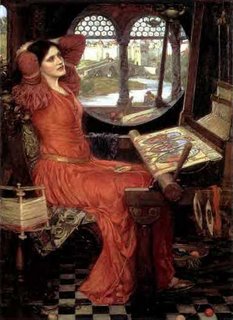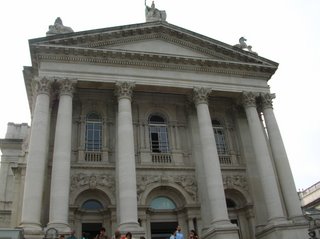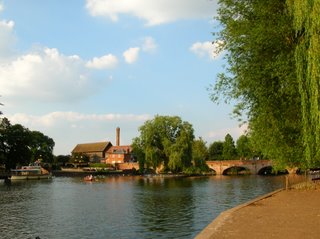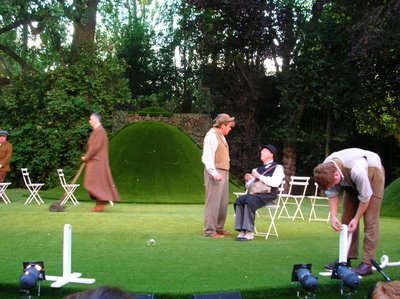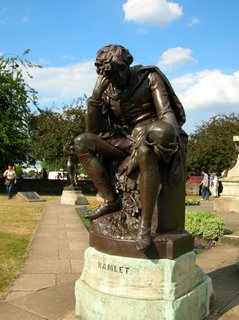Read: Several poems by W.H. Auden
This post is a continuation of
Part I.
W.H. Auden wrestled with the same thing T.S. Eliot did--whether there was any point to writing poetry. I mentioned in
Part I Eliot's line in
Four Quartets, “The poetry does not matter.” Auden wrote, similarly, in his poem "In Memory of W.B. Yeats," “Poetry makes nothing happen.” He was at a stage in his life when he was beginning to become disillusioned with poetry's role in celebrating the transitory erotic moment or bringing about revolution, but he had not yet found a replacement for these. It was to be another couple of years before he would become a Christian. The remarkable thing is how he ever did become one, in the midst of unlikely circumstances. He was a homosexual, living in Greenwich Village in a house shared with a bunch of loose-living artist types, including Golo Mann (son of Thomas Mann), composer Benjamin Britten (also gay), and Gypsy Rose Lee (a famous stripper). Auden had escaped to New York in 1939 from early fame in England which had been cramping his style. Everyone expected him to be the leading figure of his generation (the phrase "the Auden generation" first appeared in print when Auden was only 27). But in New York, he could make a fresh start and reinvent himself. After a while he started going to church (his housemates had no idea that's where he was disappearing on Sunday mornings). And he finally returned to communion in the Episcopal Church (he was familiar with the liturgy from the Anglican Church in his childhood).
So how did he become a Christian? This was a significant period of Christian renaissance. Auden was influenced by Eliot (who by this time had become a Christian), C.S. Lewis, Reinhold Niebuhr, Kierkegaard, and Pascal. An experience in a German movie theatre in Manhattan in November 1939 was a catalyst in his conversion. He saw a newsreel, a Nazi propaganda documentary about the invasion of Poland. The Germans in the audience were shouting "Kill them! Kill them!" At first he thought it was natural for the Germans to want revenge for being downtrodden in WWI, but when he realized the Poles didn't do that, and that such hatred was wrong, it ultimately brought him to Christianity. When Auden converted, he was at the height of his career, and he paid a price for it. The people who had idolized him in the past now reviled him.
Auden's turn to faith helped him to realize a responsibility to others in his poetry, the first glimpse of which had appeared back in June 1933 in England, when as Edward Mendelson writes, "Auden experienced what he later called a 'Vision of Agape.' He was sitting on a lawn with three colleagues from the school where he was teaching, when, he wrote, 'quite suddenly and unexpectedly, something happened. I felt myself invaded by a power which, though I consented to it, was irresistible and certainly not mine. For the first time in my life I knew exactly--because, thanks to the power, I was doing it--what it meant to love one's neighbor as oneself.'" (Preface to
Selected Poems)
Auden only communicated his beliefs indirectly in his poetry. There is a certain reticence, even in his poems about explicit Christian themes, which makes them more powerfully able to "bear witness" to people who might be turned off by a more outspoken apologetics. I turn to a couple of his significant poems now to give some examples of his post-conversion writing.
Excerpts from
"Friday's Child" (In memory of Dietrich Bonhoeffer, martyred at Flossenburg, April 9th, 1945)
[from Auden's
Selected Poems, edited by Edward Mendelson]
He told us we were free to choose
But, children as we were, we thought--
"Paternal Love will only use
Force in the last resort
On those too bumptious to repent"--
Accustomed to religious dread,
It never crossed our minds He meant
Exactly what He said.
...
Now, did He really break the seal
And rise again? We dare not say;
But conscious unbelievers feel
Quite sure of Judgement Day.
Meanwhile, a silence on the cross,
As dead as we shall ever be,
Speaks of some total gain or loss,
And you and I are free
To guess from the insulted face
Just what Appearances He saves
By suffering in a public place
A death reserved for slaves.When he writes "We dare not say," he doesn't mean Christians, for he believes and recites the creeds at church. He means poets. He felt that poetry was not meant for apologetics. As a poet, he can only make people stop and look at "the insulted face." He cannot tell them what to believe about the man. We are really and truly "free to choose."
Auden's long poem,
Horae Canonicae (also in
Selected Poems) is so amazing, I hope you'll indulge me as I give it a longer treatment. It traces the events of the original Good Friday of Christ's crucifixion, and also every Good Friday when we annually remember those events, and also any normal day. The epigraph “Immolatus vicerit” (a quote from the poet Venetius Fortunatus) means “the crucified one triumphs.” The poem is organized in seven sections named for the canonical hours of the monastic day: Prime, Terce, Sext, Nones, Vespers, Compline, Lauds.
It begins, in Prime, with the common human experience of waking up, before doing anything sinful in the day. We all share in this instant when "Still the day is intact, and I / The Adam sinless in our beginning, / Adam still previous to any act." But in this section there is already a foreshadowing of what is to come. "This adjacent arm" which the poet "has still to claim...as my own" upon waking, becomes "this ready flesh / No honest equal but my accomplice now, / My assassin to be, and my name / Stands for my historical share of... / ...the dying / Which the coming day will ask." The "dying" is Christ's execution.
In Terce, we humans set off into the public world, dividing into our different roles: the hangman, the judge, and the poet. Each takes his own part in the crucifixion, the first two in obvious ways. In the first stanza, there are three abstractions associated with these three roles: Justice, Law, and Truth, respectively. So the poet's role will be to bear witness to the truth. In this transition from bed out into the world, each of us prays to "get through this coming day / Without a dressing down from a superior, / Being worsted in a repartee, / Or behaving like an ass in front of the girls." If we can make it through such hurdles, "We shall have had a good Friday." And yet that last line has a double meaning, for "It is only our victim who is without a wish, / Who knows already...that, in fact our prayers are heard, / That not one of us will slip up, / That the machinery of our world will function / Without a hitch...that by sundown / We shall have had a good Friday." In other words, Christ knows before our day begins that each of us will crucify "our victim" anew by nightfall.
We move on to Sext, which comes in three parts, one for each of the three roles above. In each one, Auden builds up humor and then ends on a serious note. The key word here is "vocation." The vocation of the hangman is to be the "agent" of our victim's death. The vocation of the judge is to be the "authority" to command the death. The poet identifies himself with the "crowd" who are witnesses of the death, as we ourselves are, for "joining the crowd / is the only thing all men can do." And as men [humans], we alone (unlike ants, those "social exoskeletons") can stop our work "to worship / The Prince of this world... / at this noon, on this hill, / in the occasion of this dying."
Nones is the night hour of the day, between the crucifixion and the resurrection. The deed is done, and no sooner done than forgotten. There's a darkness over our minds as well as over the earth. "[W]e are surprised / At the ease and speed of our deed / And uneasy: It is barely three, / Mid-afternoon, yet the blood / Of our sacrifice is already / Dry on the grass." Everyone disappears to wash or eat or return to work, and "We are left alone with our feat." We go back to our hobbies, our "chalk-pit game; stamps, / Birds' eggs..." but they "are not the same." "We shall always now be aware / Of the deed into which they lead." But as long as we are still awake, "we have time / To misrepresent, excuse, deny, / Mythify, use this event." So "It would be best to go home...to rest." But instead of "our dreaming wills" being able to "escape / This dead calm," they "wander instead / On knife edges..." Our dreams torment us because of the deed we have done. In the final stanza, Auden gives us a picture of sleep as a locus for the beginning of healing, redemption. It is when
...our own wronged flesh
May work undisturbed, restoring
The order we try to destroy, the rhythm
We spoil out of spite: valves close
And open exactly, glands secrete,
Vessels contract and expand
At the right moment, essential fluids
Flow to renew exhausted cells.The grace of God to redeem us begins in our bodies, the very flesh we have wronged.
In Vespers, humanity is once again divided, this time along different lines. The poet (an Arcadian by temperament, drawn to romanticize about an innocent past) meets his anti-type, the Utopian (who looks forward to a perfected future). These are two possible ways to respond to the reality of the sinful present. But to focus on either one is to neglect part of the story. We need both. The Utopian can teach the Arcadian that there is no going back to Eden. We must go forward to the New Jerusalem, by way of sacrifice. But the Utopian teaches the Arcadian that the victim must be innocent. Ultimately, "without a cement of blood (it must be human, it must be innocent) no secular wall will safely stand." ("Without the shedding of blood, there is no remission of sin." (Heb 9:22)
Compline is the end of the day, just before sleep. It is the hour when "should come / The instant of recollection / When the whole thing makes sense." But the poet "cannot remember / A thing between noon and three." The possibility of redemption is there, but he still hasn't quite gotten it. Like pagans who try by their "magic cult to propitiate / What happens from noon till three," he still thinks that to atone for his own sin he "Must go back into non-being / For the sake of the equity..." But ultimately, he knows this is not enough. "Can poets (can men in television) / Be saved? It is not easy / To believe in unknowable justice / Or pray in the name of a love / Whose name one's forgotten:
libera / Me..." With this prayer, "free me," the poet finally accepts this love which triumphs only through the crucifixion. Now he knows "That [he], too, may come to the picnic / With nothing to hide, join the dance / As it moves in perichoresis, / Turns about the abiding tree." The picnic is Auden's image of the wedding supper of the Lamb. Perichoresis, in theology, means the dance-like interrelationships of the Trinity. And the "abiding tree" is in some sense both the Tree of Life and the Cross.
Finally we come full circle to Lauds, the praise that is offered at the beginning of a new day. The whole section is written in the form of a three-way dance, repeating occasional lines in a sort of half-villanelle. Though we are reconciled to God, the morning cock crow reminds us that we do still crucify Christ again every day. The mass-bell calls us to come to the communion table. The crowd from earlier in the poem are now a "Realm" -- a people joined together under the sovereignty of one Lord. The repeating refrain "In solitude, for company" reminds us that we all have to make our own decision about how to respond to the death of our victim. But in doing so, we are united in company with our neighbors.



